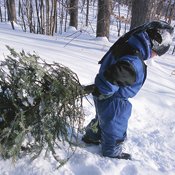Christmas may be the time to find the best deals on gifts and goodies, but it is not the time to skimp on eco-values. That means finding the best tree not only for your family traditions but also for Mother Earth. Here is the good, the bad and the ugly side of Christmas tree buying.
Leland Cyprus
Grown in a pot, and moved into your living room.
The Good: The same potted tree can be used every Christmas, and because it grows bigger every year it's an investment instead of an annual "tax." You can grow them organically, and no trees will be harmed in the making of your Christmas.
The Bad: Leland Cyprus turns a yellower color when dormant after the first frost, and may be infested with aphids, that would leave the tree in the warmth of your house and leave black spots on the carpet floor.
4-foot tree in 3 gallon pot, $24.99, Lakeland Yard and Garden Center, 601-939-7304
Leland Cyprus
From a local tree farmer.
The Good: Roy and A.B. Nichols have been growing Christmas trees in the south for 30 years at their farm in Brandon (3970 Hwy 43N). The farm is a choose-and-cut operation, so no trees are wasted. The Nichols settled on the Leland Cyprus as the most beautiful tree that grows the best in this climate, and consequently the needles hardly shed when cut.
The Bad: Nichols sprays his trees with a non-toxic green pigment after the first frost every year to offset the yellow hue the trees take on during the winter.
10-foot tree, $65, Nichols' Farm, 601-829-9945
Coniferous Tree
Harvested from the Bienville National Forest.
The Good: The Bienville National Forest is only about 45 minutes from Jackson in Forest, and would be a good excuse for families to get out in the woods together. When done carefully, harvesting certain trees for Christmas is an environmentally safe source of extra revenue from one of our state's treasures.
The Bad: The trees tend to be on the scraggly side, and the permits are nearly impossible to actually get.
Permit cost $35, Bienville National Forest, 601-965-1600
Frasier Fir
Grown in the north by local farmer.
The Good: Nichols travels to his tree farm in North Carolina every year, hand-picks the best trees, and has them cut as late in the season as possible. You can find them the day after Thanksgiving on a shaded patio at the Nichols farm, soaking up water. Frasier Firs are the tallest, best shaped and strongest of the great Christmas trees, and they smell like pure Christmas.
The Bad: They're cut and shipped from North Carolina; thus, high in fossil fuel use.
10-foot tree, $110- $150, Nichols' Farm, 601-829-9945
Frasier Fir
Bought off a store lot.
The Good: Frasier firs are the best, and they're relatively inexpensive on the lots. Despite where they're sold, a real tree is the best choice because it is still helpful to the environment. They absorb carbon during growth, and are biodegradable.
The Bad: They don't last long because they usually sit on asphalt for months, and the needles shed. They were likely cut in Michigan and shipped down using large amounts of fossil fuel. They were grown with extensive amounts of pesticides and fertilizers.
9-foot tree, $199-$239, Home Depot, 601-924-1332
Fake Plastic Tree
Bought anywhere.
The Good: They are reusable, and reassemble easily every year. Most come pre-lit as well, making the entire process pretty painless. Consider the high price an investment for years to come.
The Bad: They tend to be made of PVC (polyvinyl chloride) plastic, which is difficult to recycle. They're mostly made in China where workers are often treated poorly and products often contain toxic substances. They are also high in greenhouse gas production, both in transportation and construction.
9-foot pre-lit tree, $899, Callaway's Yard and Garden Center, 601-957-1731
Aluminum Tree
Bought anywhere.
The Good: Nothing says hip like a silver and white, aluminum Christmas tree. And now they come in a rainbow of colors so you can choose the tree to fit your mood. With their high price, you won't want to throw them away for any reason, so they're infinitely reusable.
The Bad: They are tacky, in the traditional sense of Christmas. They are hazardous to the environment in their production as well as their transportation. You may have the shiniest tree on the block but that comes with a heavy environmental price.
7-foot pre-lit tree, $219, Callaway's Yard and Garden Center, 601-957-1731
OTHER GOOD THINGS:
• Recycling: According to the Mississippi Department of Environmental Quality, recycled Christmas trees are used as fish-spawning habitats, mulch for public landscaping projects and homeowner use, for boiler fuel, and for lake, river and beachfront stabilization. "Root ball" Christmas trees can be planted in the yard when the decorations come down and will increase soil stability and air quality.
Call Jackson Parks and Maintenance Facility at 601-960-1840 for drop off sites and details for mulch pick-up.
• LED Lights: Washington's National Christmas Tree on the Ellipse and the tree in New York's Rockefeller were both lit by LED lights last year. LED lights use 25 percent of the energy of conventional light bulbs.


